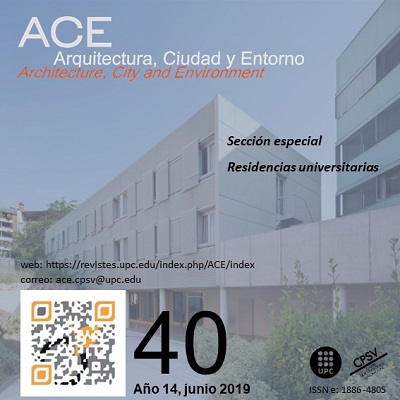Temporal conflict of urban legislation
DOI:
https://doi.org/10.5821/ace.14.40.7027Keywords:
time, space, law, cityAbstract
Objective
The architectural discipline is affected by a multitude of legislations. From the urban to the technical, different regulations influence the configuration of the city and the limits of what to build. The conflict is that they are enunciated mainly through space, placing the time factor as something residual. From disciplines such as sociology, geography or law, various researchers identify this circumstance as an impediment to improve buildings, cities or territories and adapting them to contemporary demands. This article tries to look critically at the spatial side of the law in order to raise a debate about its limitations and its possible evolution into a technological context that only diffuses its borders.
Methodology
The methodology consists of a critical and exhaustive reading of Spanish laws that affect the use and design of urban space, as well as its connection with the theoretical debate that is taking place in other fields.
Conclusions
The main consequence of the conflict is the strengthening of the public-private division, a legal and spatial separation that is imposed in building and urban legislations. This dichotomy conditions and limits the activity of architects and urban planners, but also of politicians, sociologists or economists and it represents one of the biggest problems faced by architectural design.
Originality
The critical analysis of legislations is a new field of study and practically unexplored in architecture. Making visible the role of the law on architecture can provide urban agents with new tools to intervene on it.
Downloads
Published
Issue
Section
License
| INTELECTUAL PROTECTION CRITERIA |
At this moment, it is count with the "Oficina Española de Patentes y Marcas", while global protection it is being processed by the World Intelectual Property Organization (OMPI/WIPO). Nevertheless the International Standard Serial Number Office (ISSN) has given the following numbers ISSN: 1886-4805 (electronic version) and 1887-7052 (paper version). All articles will be peer reviewed, using double blind reviewing. |
| COPYRIGHT |
The article contents and their comments are authors exclusive liability, and do not reflect necessarily the journal editor commitee's opinion. All ACE published works are subject to the following licence CC BY-NC-ND 3.0 ES http://creativecommons.org/licenses/by-nc-nd/3.0/es/ It implies that authors do not hold nor retain the copyright without restrictions but only those included in the licence. |


































